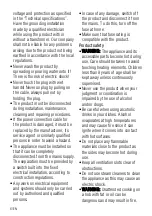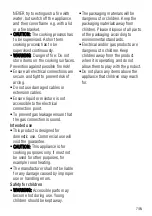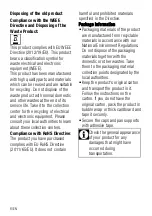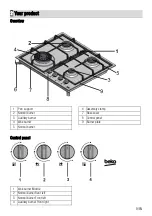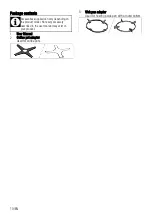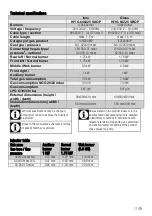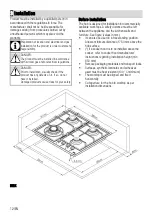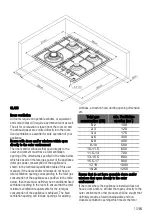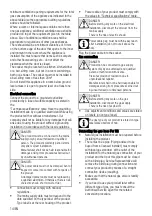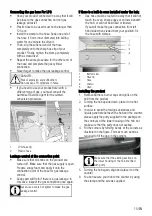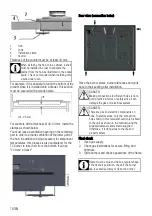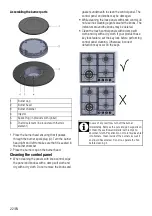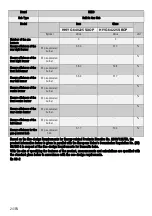
20/EN
6
Maintenance and care
General cleaning information
General warnings
•
Wait for the product to cool before cleaning the
product. Hot surfaces may cause burns!
•
Do not apply the detergents directly on the hot
surfaces. This may cause a permanent stains.
•
The appliance shall be thoroughly cleaned and dried
after each operation. Thus, food residues shall be
easily cleaned and these residues shall be
prevented from burning when the appliance is used
again later. Thus, the service life of the appliance
extends and frequently faced problems are
decreased.
•
Do not use steam cleaning products for cleaning.
•
Some detergents or cleaning agents may damage
the surface. Do not use abrasive detergents,
cleaning powders, cleaning creams, descalers or
sharp objects during cleaning.
•
There is no need for a special cleaning agent for
cleaning after each use. Clean the appliance using
dish soap, warm water and a soft cloth or sponge
and dry with a dry microfiber cloth.
•
Be sure to completely wipe off any remaining liquid
after cleaning and immediately clean any food
splashing around during cooking.
•
Do not wash any component of your appliance in a
dishwasher.
For the hob:
•
Acidic dirt such as milk, tomato paste and oil may
cause permanent stains on the cookers and
components of the burners, clean any overflown
fluids immediately after cooling down the cooker by
turning it off.
•
Wok type vessels used at high temperatures may
change colour. This is normal.
•
Moving some cookware may cause metal marks on
the pot holders. Do not slide the pans and pots on
the surface.
•
As burner caps contact the fire directly and exposed
to high temperatures, change and loss of colour in
time is normal. This does not cause a problem while
using the cooker.
Inox and stainless surfaces
•
Do not use acid or chlorine-containing cleaning
agents to clean stainless or inox surfaces and
handles.
•
Stainless or inox surface may change colour in time.
This is normal. After each operation, clean with a
detergent suitable for the stainless or inox surface.
•
Clean with a soft soapy cloth and liquid (non-
scratching) detergent suitable for inox surfaces,
taking care to wipe in one direction.
•
Remove lime, oil, starch, milk and protein stains on
the inox-stainless and glass surfaces immediately
without waiting. Stains may rust under long periods
of time.
Glass surfaces
•
When cleaning glass surfaces, do not use hard
metal scrapers and abrasive cleaning materials.
They can damage the glass surface.
•
Clean the appliance using dishwashing detergent,
warm water and a microfiber cloth specific for glass
surfaces and dry it with a dry microfiber cloth.
•
If there is residual detergent after cleaning, wipe it
with cold water and dry with a clean and dry
microfiber cloth. Residual detergent residue may
damage the glass surface next time.
•
Under no circumstances should the dried-up
residue on the glass surface be cleaned off with
serrated knives, wire wool or similar scratching
tools.
•
You can remove the calcium stains (yellow stains)
on the glass surface with the commercially available
descaling agent, with a descaling agent such as
vinegar or lemon juice.
•
If the surface is heavily soiled, apply the cleaning
agent on the stain with a sponge and wait a long
time for it to work properly. Then clean the glass
surface with a wet cloth.
•
Discolorations and stains on the glass surface are
normal and not defects.
Plastic parts and painted surfaces
•
Clean plastic parts and painted surfaces using
dishwashing detergent, warm water and a soft cloth
or sponge and dry them with a dry cloth.
•
Do not use hard metal scrapers and abrasive
cleaners. It may damage the surfaces.
•
Ensure that the joints of the components of the
appliance are not left as damp and with detergent.
Otherwise, corrosion may occur on these joints.
Cleaning the hob
Cleaning the gas burners
1. Before cleaning the hob, remove pot holders, burner
caps and heads from the hob.
2. Clean the surface of the hob as per the
recommendations included in the general cleaning
information according to the surface type
(enamelled, glass, inox, etc.).

